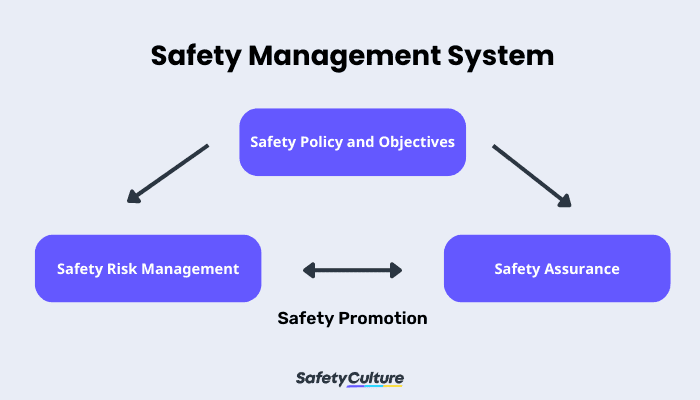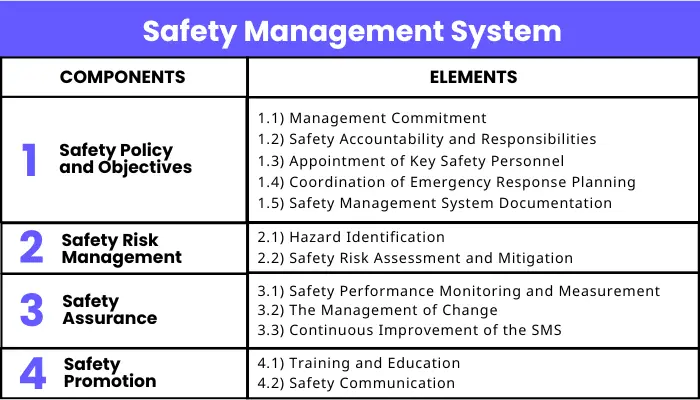What is a Safety Management System?
Safety Management System (SMS) is a collection of structured, company-wide processes that provide effective risk-based decision-making for daily business functions. Safety Management Systems help organizations offer products or services at the highest level of safety and maintain safe operations. SMS can also serve as a formal means of meeting statutory requirements such as Title 14 of the U.S. Code of Federal Regulations (CFR) enforced by the Federal Aviation Administration (FAA). According to the International Civil Aviation Organization (ICAO), the key processes of a safety management system are hazard identification, occurrence reporting, risk management, performance measurement, and quality assurance.

Safety Management System
Purpose and Benefits
The main purpose of a safety management system is to provide a systematic approach to managing safety risks in operations. It also aims to improve safety by building on existing processes, demonstrating corporate due diligence, and reinforcing the overall safety culture. Effective safety management is crucial in operating and growing the business, especially in high-risk industries, such as aviation, energy, maritime, and construction, where health and safety are paramount.
Developing safety management systems can seem daunting at first, but they are essential to promoting and ensuring workplace safety. With the right technological solution, such as a digital platform, you can streamline this process.
Some benefits of having a safety management system include the following:
- Improved safety risk management processes: Using a digital solution with free checklist templates and a smart form builder, you can easily identify hazardous working conditions, assess safety risks, and enforce control measures.
- More efficient communication: Work better together and foster a culture of collaboration by promoting openness among workers, ensuring all important information is disseminated easily.
- Centralized documentation: With a digital solution that allows you to store documents in the cloud, you can easily share files among workers anytime and anywhere. A single, unified repository also helps you refer back to any audit trail you may create to encourage continuous improvement.
4 Components and 12 Elements of a Safety Management System
Safety management systems have four components in their framework. These are:
Each SMS component contains elements that describe specific needs for the successful implementation and maintenance of a safety management system. Originated from ICAO, these 12 safety management system elements that many industries have now adopted are:
- Management Commitment
- Safety Accountability and Responsibilities
- Appointment of Key Safety Personnel
- Coordination of Emergency Response Planning
- SMS Documentation
- Hazard Identification
- Safety Risk Assessment and Mitigation
- Safety Performance Monitoring and Measurement
- Management of Change
- Continuous Improvement of the SMS
- Training and Education
- Safety Communication
The components and elements of a safety management system can be best understood together as illustrated in this image:

Safety Management System Framework: 4 Components and 12 Elements by ICAO
SMS Component #1: Safety Policy and Objectives
Employers should make safety an integral part of company values, demonstrating their commitment daily. Specifically, top management needs to set safety goals as policy while being visible and personally involved in meeting them.
Once appointed safety personnel have been identified, documentation processes should also be determined because the safety management system will be reviewed periodically to ensure it remains relevant and appropriate to the organization.
SMS Component #2: Safety Risk Management
In order to effectively control safety risks, designated staff should perform a series of interconnected processes collectively called Safety Risk Management (SRM). Listed below are the 5 steps that go into the safety risk management component of SMS:
- System Description and Task Analysis: As a system design function, system description and task analysis are used by a cross-functional team within the organization to state the facts about the activities and workplace conditions (equipment, environment, etc.) involved in their processes.
- Hazard Identification: Hazards are any real or potential condition, including typical hazardous conditions related to human error, such as time pressure, shift turnovers, and lack of system knowledge that can cause injury, illness, or death to people and/or system, equipment, or property damages or losses.
- Risk Analysis: Analyzing risk involves considering the likelihood and severity of adverse consequences. Since a single hazard can have multiple consequences, increased exposure to hazards can also make it more likely for grave consequences to recur.
- Risk Assessment: To assist with decision-making, perform a risk assessment with a risk matrix and establish whether a safety risk is acceptable or not. If deemed acceptable, the SRM component of safety management systems is complete, and the risk moves to the next component for monitoring. Otherwise, risk controls should be put in place to mitigate or reduce the risk.
- Risk Control: While the severity of risks may be lessened to a certain degree, decreasing their probability or likelihood is what happens in most situations. Risk controls applied to working conditions can be effective instruments for risk reduction and failure prevention.
| Risk Likelihood | Risk Severity | |||||
| Catastrophic A |
Hazardous B |
Major C |
Minor D |
Negligible E |
||
| Frequent | 5 | 5A | 5B | 5C | 5D | 5E |
| Occasional | 4 | 4A | 4B | 4C | 4D | 4E |
| Remote | 3 | 3A | 3B | 3C | 3D | 3E |
| Improbable | 2 | 2A | 2B | 2C | 2D | 2E |
| Extremely Improbable |
1 | 1A | 1B | 1C | 1D | 1E |
SMS Component #3: Safety Assurance
Safety Assurance (SA) is the component of a safety management system that deals with monitoring risk controls during operations. Common SA functions include internal audits, investigations, and employee reporting systems.
Upon gathering all necessary information, these should be analyzed against set objectives and compared with existing norms for patterns from multiple data points and trends over time. Oftentimes, safety risk controls fail due to a lack of leadership, resources, and instruction. In whichever case, preventive and corrective actions should be taken.
SMS Component #4: Safety Promotion
Interchangeably used with Safety Culture, Safety Promotion is defined as the activities that support safety management systems in an organization, such as training, knowledge-sharing, and communication. Management should also be able to explain why particular actions are taken to foster an environment for open reporting of safety concerns.
Improve your EHS Management
Cultivate a safe working environment and streamline compliance with our EHS solutions.
Explore nowExample Uses
Some use cases for safety management systems include the following:
- Hazard identification within a workplace and conducting the proper analysis for it
- General risk assessment and control
- Data gathering for informed decision-making regarding safety concerns
- Solutions to existing safety concerns
Create your own Safety Management System checklist
Build from scratch or choose from our collection of free, ready-to-download, and customizable templates.
Browse safety checklistsRole of Training in Safety Management
Training plays a crucial role in the implementation and effectiveness of safety management systems. Training sessions that outline the necessary steps and obligations for safety management help ensure that employees are equipped with the knowledge and skills to identify and mitigate hazards, follow safety procedures, and respond to emergencies.
Additionally, regular training helps keep your organization compliant with different safety standards. It ensures that employees are constantly updated on important changes and concerns, as well as with different new processes and procedures.
Online training courses, in particular, are beneficial for seamlessly facilitating training for safety management systems. With these kinds of training content, you and your employees can train anytime and anywhere, all at your own pace.
FAQs about Safety Management Systems
The aviation industry requires all businesses to have their own safety management systems, as they are essential in managing and mitigating risks in the air and the transport of goods and people.
In particular, the US FAA has multiple regulations on the proper creation and implementation of them for all aviation businesses to follow. The International Air Transport Association (IATA) also has provisions for properly creating and carrying out safety management systems.
Safety management systems are implemented in different ways across different industries. While the aviation industry has the same ways of implementing safety management systems, there are some differences in how they do so.
Some considerations specific to the aviation industry that one must be aware of include:
- Regulations set by different aviation organizations
- Operational context of the organization, including the type of operations, fleet composition, and the specific challenges faced
- Legal regulations of different localities and countries
Implementing a safety management system the right way to fit your organizational needs can improve both your employees’ work experience and the quality of their work. By promoting safety in the workplace, you help foster a culture of improvement, enhancing management commitment and accountability. The output your organization provides will also be of a higher quality, thus improving sales and brand reputation.
For some organizations, it can take as little as three to four months to properly create and implement a safety management system. For others, it can take 12 to 24 months and then another 18 months to see results.




